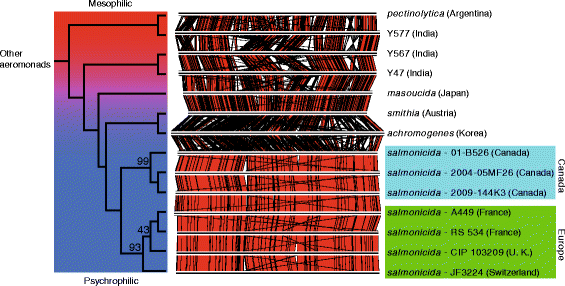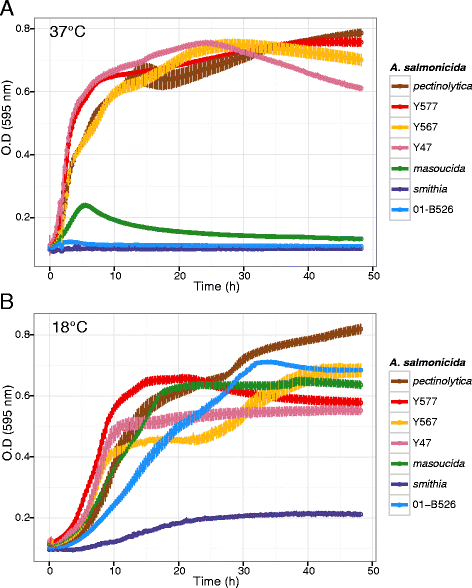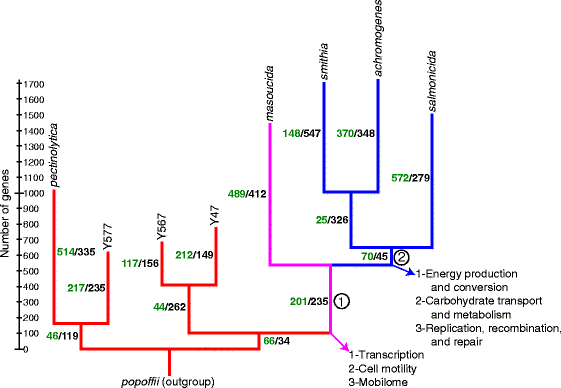Increasing genomic diversity and evidence of constrained lifestyle evolution due to insertion sequences in Aeromonas salmonicida
- PMID: 26753691
- PMCID: PMC4709979
- DOI: 10.1186/s12864-016-2381-3
Increasing genomic diversity and evidence of constrained lifestyle evolution due to insertion sequences in Aeromonas salmonicida
Abstract
Background: Aeromonads make up a group of Gram-negative bacteria that includes human and fish pathogens. The Aeromonas salmonicida species has the peculiarity of including five known subspecies. However, few studies of the genomes of A. salmonicida subspecies have been reported to date.
Results: We sequenced the genomes of additional A. salmonicida isolates, including three from India, using next-generation sequencing in order to gain a better understanding of the genomic and phylogenetic links between A. salmonicida subspecies. Their relative phylogenetic positions were confirmed by a core genome phylogeny based on 1645 gene sequences. The Indian isolates, which formed a sub-group together with A. salmonicida subsp. pectinolytica, were able to grow at either at 18 °C and 37 °C, unlike the A. salmonicida psychrophilic isolates that did not grow at 37 °C. Amino acid frequencies, GC content, tRNA composition, loss and gain of genes during evolution, pseudogenes as well as genes under positive selection and the mobilome were studied to explain this intraspecies dichotomy.
Conclusion: Insertion sequences appeared to be an important driving force that locked the psychrophilic strains into their particular lifestyle in order to conserve their genomic integrity. This observation, based on comparative genomics, is in agreement with previous results showing that insertion sequence mobility induced by heat in A. salmonicida subspecies causes genomic plasticity, resulting in a deleterious effect on the virulence of the bacterium. We provide a proof-of-concept that selfish DNAs play a major role in the evolution of bacterial species by modeling genomes.
Figures





Similar articles
-
The complete and fully assembled genome sequence of Aeromonas salmonicida subsp. pectinolytica and its comparative analysis with other Aeromonas species: investigation of the mobilome in environmental and pathogenic strains.BMC Genomics. 2018 Jan 5;19(1):20. doi: 10.1186/s12864-017-4301-6. BMC Genomics. 2018. PMID: 29304740 Free PMC article.
-
Study of mesophilic Aeromonas salmonicida A527 strain sheds light on the species' lifestyles and taxonomic dilemma.FEMS Microbiol Lett. 2017 Dec 15;364(23). doi: 10.1093/femsle/fnx239. FEMS Microbiol Lett. 2017. PMID: 29126137
-
The genome of Aeromonas salmonicida subsp. salmonicida A449: insights into the evolution of a fish pathogen.BMC Genomics. 2008 Sep 18;9:427. doi: 10.1186/1471-2164-9-427. BMC Genomics. 2008. PMID: 18801193 Free PMC article.
-
Virulence, genomic features, and plasticity of Aeromonas salmonicida subsp. salmonicida, the causative agent of fish furunculosis.Vet Microbiol. 2014 Feb 21;169(1-2):1-7. doi: 10.1016/j.vetmic.2013.06.025. Epub 2013 Jul 9. Vet Microbiol. 2014. PMID: 23890675 Review.
-
The Aeromonas salmonicida plasmidome: a model of modular evolution and genetic diversity.Ann N Y Acad Sci. 2021 Mar;1488(1):16-32. doi: 10.1111/nyas.14503. Epub 2020 Oct 10. Ann N Y Acad Sci. 2021. PMID: 33040386 Review.
Cited by
-
Lineage-specific evolution of Aquibium, a close relative of Mesorhizobium, during habitat adaptation.Appl Environ Microbiol. 2024 Mar 20;90(3):e0209123. doi: 10.1128/aem.02091-23. Epub 2024 Feb 27. Appl Environ Microbiol. 2024. PMID: 38412007 Free PMC article.
-
Characterization of atypical pathogenic Aeromonas salmonicida isolated from a diseased Siberian sturgeon (Acipenser baerii).Heliyon. 2023 Jul 3;9(7):e17775. doi: 10.1016/j.heliyon.2023.e17775. eCollection 2023 Jul. Heliyon. 2023. PMID: 37483743 Free PMC article.
-
The complete and fully assembled genome sequence of Aeromonas salmonicida subsp. pectinolytica and its comparative analysis with other Aeromonas species: investigation of the mobilome in environmental and pathogenic strains.BMC Genomics. 2018 Jan 5;19(1):20. doi: 10.1186/s12864-017-4301-6. BMC Genomics. 2018. PMID: 29304740 Free PMC article.
-
Epidemiology of Danish Aeromonas salmonicida subsp. salmonicida in Fish Farms Using Whole Genome Sequencing.Front Microbiol. 2017 Dec 5;8:2411. doi: 10.3389/fmicb.2017.02411. eCollection 2017. Front Microbiol. 2017. PMID: 29259599 Free PMC article.
-
Draft Genome Sequences of Four Aeromonas salmonicida subsp. achromogenes Strains, 23051, 23053, 23055, and 23056, Isolated from Senegalese Sole (Solea senegalensis).Microbiol Resour Announc. 2019 Aug 15;8(33):e00631-19. doi: 10.1128/MRA.00631-19. Microbiol Resour Announc. 2019. PMID: 31416869 Free PMC article.
References
-
- Martin-Carnahan A, Joseph S. Aeromonadales ord. nov. In: Brenner D, Krieg N, Staley J, Garrity G, Boone D, De Vos P, editors. Bergey’s Manual® Syst. Bacteriol. SE - 12. Springer US. 2005. pp. 556–587.
-
- Percival SL, Williams DW. Gray of WD (Second E, editor. London: Academic; 2014. Chapter Three - Aeromonas; pp. 49–64.
-
- Palumbo SA, Morgan DR, Buchanan RL. Influence of Temperature, NaCI, and pH on the Growth of Aeromonas Hydrophila. J Food Sci. 1985;50:1417–1421. doi: 10.1111/j.1365-2621.1985.tb10490.x. - DOI
-
- Park S, Ha S-D. Effect of temperature on the growth kinetics and predictive growth model of Aeromonas hydrophila on squid (Sepioteuthis sepioidea) Food Sci Biotechnol. 2014;23:307–312. doi: 10.1007/s10068-014-0043-2. - DOI
Publication types
MeSH terms
Substances
LinkOut - more resources
Full Text Sources
Other Literature Sources
Miscellaneous

